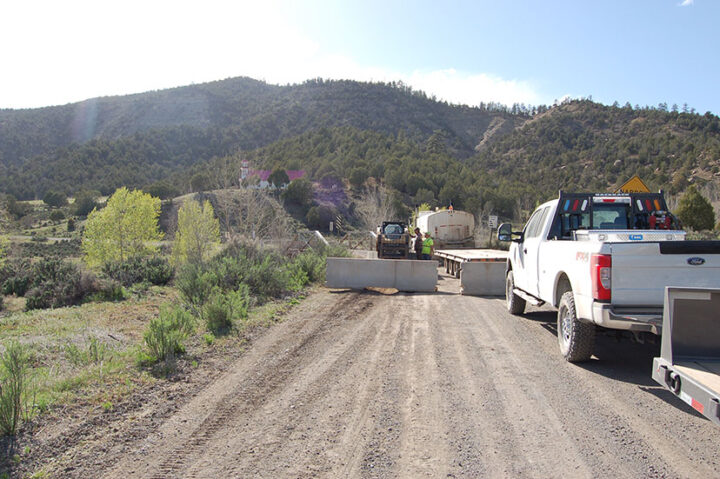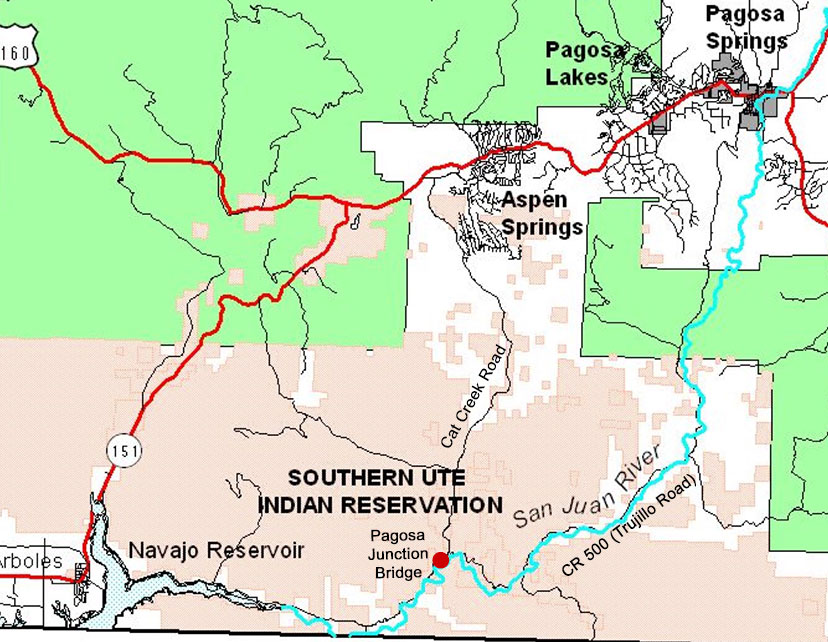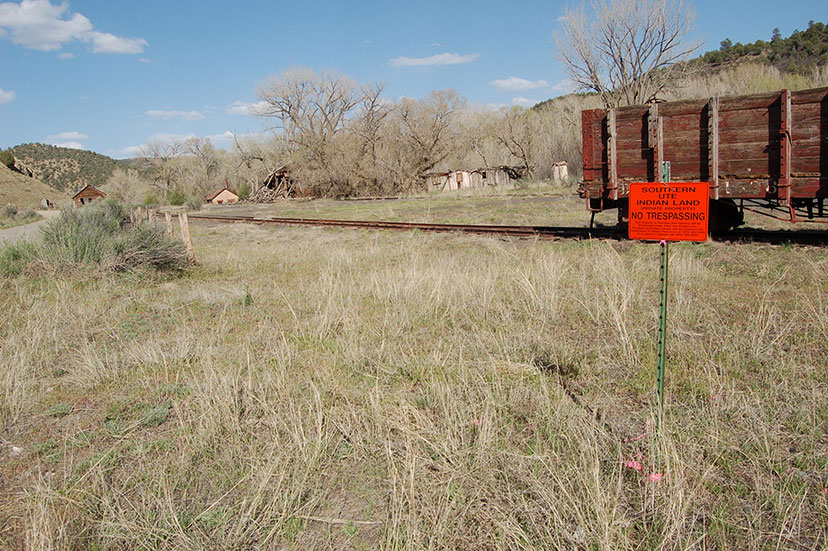PHOTO: Tracks leading to the long-abandoned Pagosa Junction train station. The orange sign reads, “Southern Ute Indian Land (Private Property) No Trespassing”.
After listening to the complaints about the scheduled closure of the Pagosa Junction Bridge from two concerned citizens — LuAnn Baker and Chris Ribera — at the May 2 Archuleta Board of County Commissioners’ meeting, BOCC chair Ronnie Maez engaged in a bit of conversation with the two.
Back-and-forth conversations with taxpayers during public comment is not a traditional occurrence at BOCC meetings, but it seems to have become more common with our current set of commissioners, and perhaps with Ronnie Maez in particular. Perhaps, back-and-forth conversations are what is primarily needed, regarding the now-closed bridge.
Mr. Ribera had delivered an appeal, asking the BOCC to leave the bridge open to non-commercial vehicles, and to engage fully with the Southern Ute Indian Tribe (SUIT) to resolve the communication roadblocks.
Commissioner Maez:
“At this morning’s work session, I brought out all the emails that have been communicated back between the Southern Utes and Archuleta County. And the only response we got back was concerning the emergency order, cleaning out the culverts and the mud erosion that happened earlier in the year. That is the last communication we had with them.”
Mr. Ribera:
“So Tracy didn’t get with anybody, over the past couple of days?” (Presumably, Mr. Ribera was referring to Tracy Mickey, Permits and Rights-of-Way Specialist with the Southern Ute Indian Tribe.)
Commissioner Maez asked County Manager Derek Woodman and County Attorney Todd Weaver if they had received any communication, and both replied, “No.”
“So there you go,” Commissioner Maez told the two citizens.
The situation is complicated. Decades ago, the SUIT and the Archuleta County government signed an agreement, specifying that Archuleta County would maintain County Road 500, aka Trujillo Road, even though the road passes through mainly Tribal land. Presumably, that would include maintenance of the Pagosa Junction Bridge.
Since that agreement, the bridge has deteriorated to a point where it is no longer safe to use.
But in order to replace the bridge (or repair it), Archuleta County needs permission from the Tribe to conduct engineering work and construction impacting the surrounding Southern Ute property. To date, the County has not obtained that permission. So the bridge was officially closed on Friday.

Chris Ribera:
“I just think we need to slow down and look at this some other way…”
Commissioner Maez:
“We’ve been trying to communicate and get things done for the last six years, since I’ve been a commissioner… and to no avail.”
LuAnn Baker banged her fist on the podium.
“I will invite you to my house… and I will invite the Tribe to my house… and we’ll have a sit down.”
Commissioner Maez:
“I appreciate the invitation, LuAnn.”
Ms. Baker:
“You’re invited. I’ll call Mike Olguin and say, ‘Come out’. This needs to be fixed.” (James M. “Mike” Olguin is the Tribe’s Executive Director.)
To put some kind of face on this situation, here’s a map. The red dot shows the location of the Pagosa Junction Bridge; the brown areas are Southern Ute property. The green areas are U.S. Forest Service land. That leaves “white” as privately-owned land.
As we see, much of the southwestern corner of Archuleta County is Indian land, amounting to about 14% of Archuleta County. That can be compared to about 31% of the county in private ownership.

The Southern Ute reservation extends across the southern-most part of southwest Colorado, measuring about 15 miles north to south and 100 miles east to west. The Tribe has approximately 1,400 tribal members, with half the population under the age of 30.
To understand the awkward situation with the Pagosa Junction Bridge and the overall maintenance issues of the County roads that pass through the Southern Ute reservation, it probably helps to know a bit about Southern Ute history. Here are a few facts taken from the SUIT website. You can read the more complete history at https://www.southernute-nsn.gov/history/
The Southern Ute Tribe is composed of two bands, the Mouache and Caputa. Around 1848 Ute Indian Territory included traditional hunting ground s in Wyoming, Utah, Arizona, New Mexico, Oklahoma and Texas. In 1868 a large reservation was established for the Southern Utes that covered the western half of Colorado consisting of 56 million acres. In 1873, after gold and silver was discovered in the San Juan Mountains, the Brunot Agreement was created. The Agreement substantially diminished Southern Ute lands, depriving the tribe of seasonal camps, and annual elk and deer harvests. Around 1895 the Southern Ute reservation was created. It was 15 miles wide and 110 miles long. In 1895 the Hunter Act enabled lands within the Ute Strip to be allotted to tribal members, and the surplus lands homesteaded and sold to non-Indians…
The tribe is governed by a seven-member Tribal Council elected by the membership. Principle officers include the Chairman, Vice-Chairman and Treasurer, with all council members serving three-year staggered terms. Tribal government is based on a Tribal Constitution adopted November 4, 1936, that was revised in September 1975. Although the tribe strives to provide strong social welfare and education programs, they also emphasize the importance of the traditional way of life. They sponsor the annual Sun Dance and Bear Dance. Tribal members of all ages participate in Pow-wows.
Tribal Council recognized the importance of traditional healing and has incorporated this method into the health services program.
I had a chance to sit down with Archuleta Commissioner Warren Brown yesterday, to get some of his perspective on the dynamics that have led up to the closure of the Pagosa Junction Bridge on May 5. He noted that the BOCC met with the Southern Ute Tribal Council in “May or June” last year to discuss County Road 500.
“My take on this is that the Tribal Council has been very thoughtful, and has been listening to our requests, and to the status that we’ve given them on a number of projects, and one specifically concerning CR 500. We all agreed and scheduled to meet last year, onsite at the Bridge, and also further north on 500 where the road is washing away.
“I felt that we had very good participation… very good conversation. And it was evident that the bridge is in pretty poor shape… I wasn’t at all surprised when we got the notice from CDOT (Colorado Department of Transportation) that the bridge should either be repaired, replaced, or the road should be closed… After walking around it, and under it, I’m surprised it hasn’t been closed, to this point…
“I think there’s a stark cultural difference, obviously, between the Southern Ute Indian Tribe — being a sovereign nation that they are — and Archuleta County, And I’m not a cultural expert by any means, but it appears to me that the Council likes to engage in conversation, hear information… but for whatever reason… and maybe it’s just a ‘lessons learned’… they don’t like to make decisions quickly. They like to look at all the angles. And I don’t blame them one bit…”

